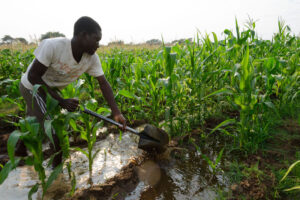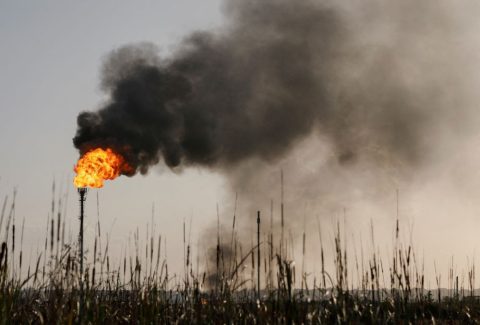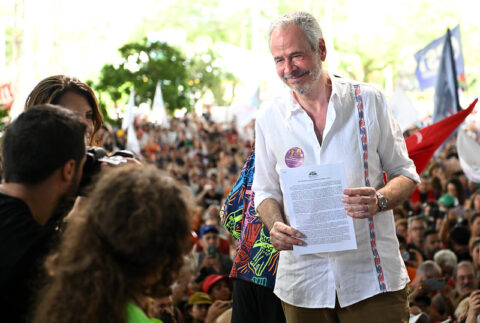Developing countries are receiving just a fraction of the international finance they need to prepare citizens and adapt infrastructure for escalating climate impacts.
That is according to the latest adaptation gap report from the UN Environment Programme (UNEP), which calculates that developing nations will need more than $310bn annually between now and 2035 to prepare for the impacts of climate change.
And yet, in 2023, developed nations provided just $26bn in international adaptation finance to developing nations, according to the report.
UNEP warns that, under current trends, developed nations are on track to miss their goal – agreed at the COP26 climate summit in Glasgow – of doubling 2019 international adaptation finance by 2025.
It cautions that countries’ more recent climate-finance pledge for 2035 – the new collective quantified goal (NCGQ) – will be “insufficient” to meet adaptation finance needs.
The UN report – entitled, “Running on empty: The world is gearing up for climate resilience without the money to get there” – also explores how countries are integrating adaptation priorities into national climate plans, policies and practices.
It finds that 87% of countries have at least one national adaptation plan or strategy in place, but warns that gaps remain in the implementation of measures.
Inger Andersen, the executive director of UNEP, says: “Even amid tight budgets and competing priorities, the reality is simple: if we do not invest in adaptation now, we will face escalating costs every year.”
Below, Carbon Brief summarises some of the key takeaways from the report.
- Developed countries are on track to miss their 2025 adaptation finance goal
- Developing nations’ adaptation finance needs are 12 times greater than current flows
- A majority of countries have a national adaptation plan or strategy in place
- Implementation of adaptation measures is progressing – but gaps remain
- The NCQG is insufficient on its own to meet adaptation finance needs
Developed countries are on track to miss their 2025 adaptation finance goal
Climate change adaptation refers to a range of measures that reduce society’s and infrastructure’s vulnerability to climate change, from planting crop varieties that can withstand greater heat through to building stronger defences against floods.
Spending from the public funds of developed nations is a key source of finance for these actions in developing nations, especially for low-income countries that are vulnerable to climate impacts.
Under Article 9 of the Paris Agreement, developed countries agreed to achieve a “balance” in the amount of climate finance raised for emissions reduction and adaptation. However, more money has been raised for cutting emissions than preparing for climate impacts.
UNEP’s adaptation gap report notes that, in 2023, the amount of public money channelled to developing countries from richer nations for adaptation measures fell.
In total, developed countries raised $25.9bn in international adaptation finance – marking a decline on the $27.9bn recorded in 2022.
The report authors attribute the fall to a decline in funding from multilateral development banks, such as the World Bank, which provided more than half – 57% – of international adaptation finance.
The table below shows how adaptation finance provided by developed countries for developing countries (orange) dipped in 2023 – despite an uptick in climate finance as a whole.
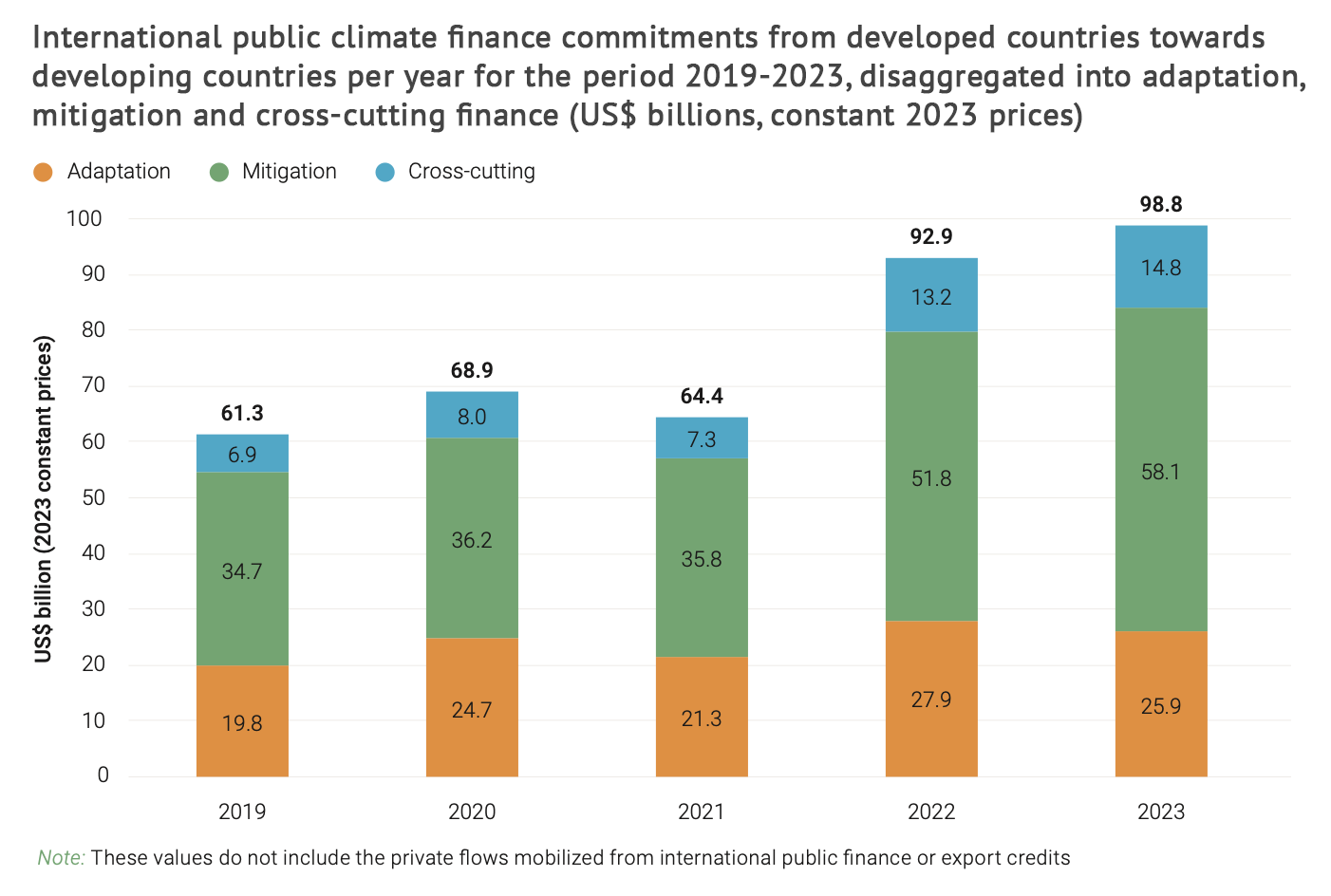
The UN warns that, if current trends continue, developed nations are set to miss their goal of doubling 2019 adaptation finance flows by 2025.
This goal – set out in the Glasgow Climate Pact agreed at the COP26 climate summit in 2021 – commits developed nations to providing $40bn in adaptation funding for developing nations by 2025.
Official climate-finance figures from the Organisation for Economic Co-operation and Development (OECD) for 2025 will not be available for several years. However, the report notes that, over 2019-23, international adaptation finance grew at a compound rate of 7% – falling short of the 12% rate required to meet the Glasgow Climate Pact goal.
Cuts to international aid budgets since 2023 are also threatening the Glasgow Climate Pact goal, according to the report authors. They note that, globally, foreign aid fell by 9% in 2024 and predict that reductions announced in 2025 are “likely” to lead to a further 9-17% decline.
Meanwhile, countries’ more recent pledge to help raise $300bn a year by 2035 for both tackling and adapting to climate change – set out in the new collective quantified goal for climate finance (NCQG), agreed last year at COP29 in Baku – is also under threat, according to the report.
In the introduction of the report, UNEP’s Anderson writes:
“While the numbers for 2024 and 2025 are not yet available, one thing is clear: unless trends in adaptation financing do not turn around, which currently seems unlikely, the Glasgow Climate Pact goal will not be achieved, the NCQG will not be achieved and many more people will suffer needlessly.”
‘Adaptation investment trap’
The report also breaks down international adaptation finance in 2023 by funding type. It finds that that 70% was either grants, which allow countries to address climate impacts without exacerbating debt, or “concessional” loans, which are provided at below market rate.
However, it notes that “non-consessional” finance – which is provided at, or near, market rates – is on the rise, growing at an annual compound rate of 7% over 2019-23. In 2023, non-concessional loans exceeded concessional ones for the first time, the report notes.
The “increasing proportion” of non-concessional finance raises “long-term affordability and equity” concerns, the authors warn. They also point to the risk of an “adaptation investment trap” – whereby rising climate disasters increase developing countries’ “indebtedness”, which subsequently makes it harder for them to invest in adaptation.
The report also finds that loans and other forms of “debt instruments” comprised “58% on average” of international adaptation finance in 2022-23.
The NCQG text highlights the need for “concessional” and “non-debt creating” finance.
(This came after strong calls from many developing countries to exclude “non-concessional” loans – which result in wealth flowing back to the donor countries as loan repayments and interest – as a form of climate finance. Analysis has shown that many developing countries are spending more on servicing debts than they receive in climate finance.)
Elsewhere, the authors also find that funding for new adaptation projects through UN Framework Convention on Climate Change (UNFCCC) funds (the adaptation fund, green climate fund (GCF) and the least developed countries fund (LDCF) and special climate change fund (SCCF) managed by the Global Environment Facility) saw a “large spike” in 2024, with grants reaching around $920m.
However, they note that the recent increase “may not be a trend, with financial constraints likely to rise beyond 2025”.
Developing nations’ adaptation finance needs are 12 times greater than current flows
While previous UN adaptation gap reports have investigated adaptation finance shortfalls through to 2030, this latest analysis extends its estimates through to 2035.
This is in light of the NCQG, which states that developed countries should “take the lead” in raising “at least $300bn” a year for climate action in developing countries by 2035.
The report calculates that the costs of adaptation by 2035 for developing countries sit in a “plausible central range” of $310-365bn annually. It explains that it has arrived at this range based on “two lines of evidence”:
- A modelled estimate of the additional costs of adaptation, calculated using “global sectoral models with national-level resolution”. This exercise pins the cost of adaptation for developing countries at $310bn a year by 2035 under an intermediate emissions scenario.
- An analysis of the climate finance needs set out by developing countries in 97 national adaptation plans and nationally determined contributions (NDCs) submitted to the UNFCCC – with “extrapolation” of this data to all 155 developing countries. This results in the upper figure of $365bn per year up to 2035.
The chart below shows the disparity between existing finance flows (dark blue bar) and adaptation finance needs and modelled costs (red bars).
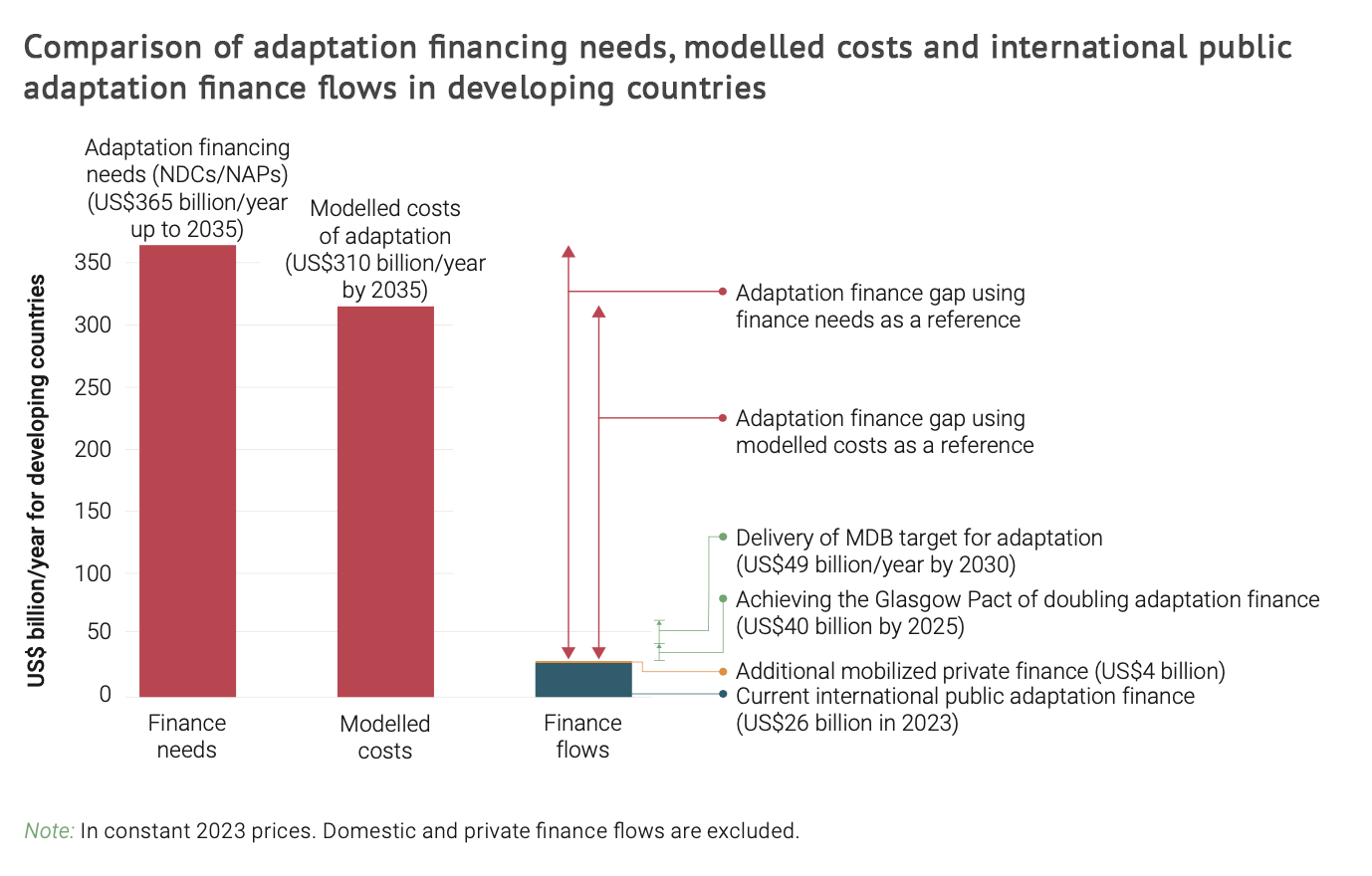
With current levels of international adaptation finance estimated at $26bn a year, the report calculates that developing countries are facing an “adaptation finance gap” in the range of $284-339bn per year by 2035.
As such, it calculates that the adaptation finance needs of developing countries by 2035 are “12-14 times” as much as current finance flows.
Of the public adaptation finance that has been issued, a higher proportion currently goes to the countries most exposed to climate hazards, according to the report. It notes that, in 2022-23, $10.4bn and $1.2bn was allocated to least-developed countries (LDCs), including Afghanistan and Rwanda, and small island developing states (SIDS), such as Tuvalua and the Marshall Islands, respectively.
Nevertheless, finance provided to these climate-vulnerable nations is still “modest relative to needs”, the report warns. It estimates that the adaptation finance needs of LDCs and SIDS are $50bn a year.
It also finds that per-capita adaptation finance to both country groups was lower in 2022-23 than previous years, at $9 for LDCs and $20 in SIDs.
A majority of countries have a national adaptation plan or strategy in place
Under the framework for the global goal on adaptation agreed at COP28, countries said they would put in place “national adaptation plans, policy instruments and planning processes and/or strategies” by 2030.
To assess the “global status” of national adaptation planning, the authors of the report tracked the publication of national plans, strategies and policies for adaptation in each country.
According to the report, the first national adaptation policy was published in 2002. It finds that there was a “notable acceleration” in countries developing national adaptation planning instruments over 2011-21, but says that, since then, progress has “slowed significantly”.
According to the report, 87% of countries had at least one national adaptation policy, strategy or plan in place as of 31 August 2025. However, 36 of these 172 countries’ plans are “expired” or “outdated”.
Meanwhile, 25 countries had no national adaptation plan at all, according to the report. It explains that these are “predominantly developing countries, suggesting that financial, technical and human resource constraints inhibit national adaptation planning”.
Of these countries without plans, 21 have “initiated a process to develop” a national adaptation plan, according to the report. However, it notes that many of these countries have “been in this process for a long time”.
The chart below shows the percentage of countries from different “country classifications” that have no national adaptation planning instrument in place (red), an expired adaptation planning instrument in place (yellow) and a valid instrument in place (green).

The report also discusses different types of adaptation “mainstreaming”. This is defined by the report authors as the “integration of adaptation objectives and climate risk considerations into the established functions, policy and practice of government institutions to build climate resilience”.
The authors list six different mainstreaming strategies. For example, “directed” mainstreaming means “dedicating funding, staff capacity-building and resources specifically to adaptation, including through financial frameworks and fiscal processes such as budget planning”.
Another example is “regulatory mainstreaming”, which means “modifying the formal or informal policy instruments such as legislation, frameworks, strategies and plans by integrating adaptation”.
According to the report, only regulatory mainstreaming is captured by the framework for the global goal on adaptation’s target related to planning.
The report also outlines the different “levels” of mainstreaming. These range from “prioritisation”, which it describes as a strong level of mainstreaming in which adaptation takes precedence over existing policy goals, to “coordination”, in which adaptation “is recognised as a policy goal, but is secondary to existing priorities”.
However, the report says there is “presently no agreement on how to measure and assess the outcomes of mainstreaming”.
Implementation of adaptation measures is progressing – but gaps remain
Under the UN “enhanced transparency framework”, countries are required to submit information about their climate progress in biennial transparency reports (BTR). The first report was due at the end of 2024.
The adaptation gap report calls BTRs the “most comprehensive national source of information on adaptation implementation worldwide available”.
The report says that 105 countries had submitted BRTs as of 31 August 2025, of which 94 include details about adaptation
The authors find that 75 of these BTRs mention gender in relation to adaptation. However, only 4% of the results reported through BTRs are directly related to “gender and social inclusion”.
The report also highlights the “uneven coverage” of BTRs globally. According to the report, 88% of developed countries have submitted a BTR, compared to only 37% of developing countries.
It adds that there are further inequalities within the bracket of “developing countries”. Only 21% of SIDS and 14% of LDCs have submitted BTRs with “detailed information on climate impacts and adaptation”, according to the report.
This could “indicate that preparing national reports such as BTRs is most burdensome for the countries with the least capacity”, the report authors suggest.
The map below shows the countries that have submitted a BTR including “detailed information on climate impacts and adaptation” (blue) and those that have not (grey). For the former category, darker blue indicates that the country’s BTR includes more segments of text (data points) about climate impacts and adaptation.
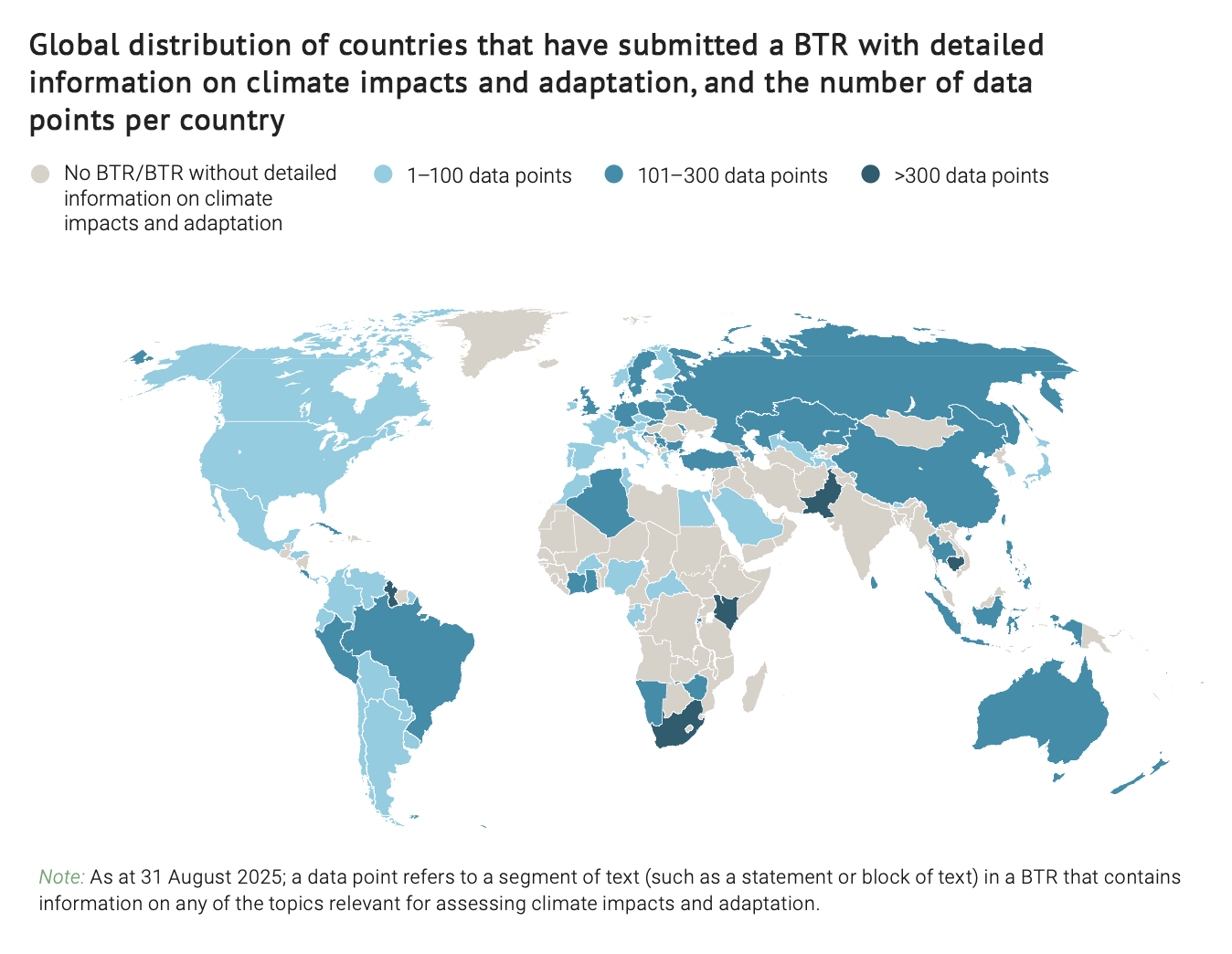
The report finds that countries are “disproportionately reporting on climate hazards, systems at risk, climate change impacts and adaptation priorities” in BTRs. Meanwhile, only 15% and 7% of the data points in the map above discuss adaptation “actions” and “results” respectively.
In total, the report identifies 1,640 “adaptation actions” across 68 BTRs. It says that 23% of these are related to “biodiversity and ecosystems”, 18% to “infrastructure and human settlements”, 16% to “water and sanitation” and 14% to “food and agriculture”.
However, it finds that actions targeting health and poverty alleviation or livelihoods are each accounting for only 5%, while those addressing cultural heritage are “nearly absent” and account for less than 1% of all reported actions.
In a separate analysis, the report explores documents submitted by developing countries to the UNFCCC to understand how adaptation needs break down by sector. It finds that the 55 plans submitted by developing countries which include “detailed sectoral information” reveal that the agriculture and food sector and water supply are “common priorities across all regions, though they vary in terms of their relative importance”.
The NCQG is insufficient on its own to meet adaptation finance needs
At COP29 last year, developed nations pledged to raise at least $300bn per year under the NCQG for both mitigation and adaptation.
The report says that, although the target “appears significantly higher than the previous goal for developed countries to mobilise $100bn by 2020 for developing countries”, it is still “clearly insufficient” to meet adaptation finance needs in 2035.
The report sets out two reasons for this.
First, the authors explain that the $300bn target is not adjusted for inflation. It says that adaptation costs for developing countries are currently estimated at $310-365bn annually until 2035, based on costs in 2023. However, when adjusting for an inflation rate of 3% per year for the next decade, this number rises to US$440–520bn by 2035.
(In an analysis published last year, Carbon Brief noted that the $300bn target does not account for inflation.)
The plot below shows the effect of inflation on adaptation finance needs (dark blue) and modelled costs (light blue). It also shows the NCQG goal, accounting for inflation, based on 2023 costs (red) and without inflation based on 2035 costs (pink). It also shows the NCQG goal of $300bn by 2035 (yellow).

Second, it notes that the NCQG covers both mitigation – namely, efforts to cut emissions – and adaptation. So far, it warns that no “subgoal” has been agreed to determine how much money goes to each.
The report authors have also developed two scenarios exploring how much the NCQG would bridge the adaptation finance gap, if the $300bn target is met, both of which account for inflation. These are:
- A “minimum adaptation scenario”. The authors assume that 26% of the NCQG money will be used for adaptation finance as this is the percentage of all international climate finance that was spent on adaptation over 2011-20. Based on historical proportioning of finance, $3bn of the resulting $78bn this would go to SIDS and the rest to $25bn to LDCs.
- A “maximum adaptation scenario”. Under this scenario, the Glasgow Pact and Baku to Belém Roadmap are achieved, meaning that adaptation funding reaches $40bn annually by 2025 and $120bn annually by 2030. They also assume that adaptation finance grows by 7% per year, reaching $166bn by 2035 – more than half of the NCGQ finance goal of $300bn. Under this scenario, SIDS would receive $6bn in adaptation funding by 2035 and LDCs would receive $55bn.
The report concludes that, even if the NCQG is achieved, a “significant adaptation finance gap” is likely to remain in 2035 “regardless of the share of international public climate finance that will flow towards adaptation”.
Meanwhile, the report notes that private-sector finance can help “fill the adaptation finance gap” – but cautions that its overall contribution is likely to be “modest”.
The “realistic” potential for private-sector investment, according to the report, is $50bn per year by 2035 – a figure it estimates would cover 15-20% of overall estimated needs.
Reaching this level of private-sector finance will require “targeted policy action” given that current private-sector flows to “publicly identified” adaptation priorities in 2023 are estimated at $5bn, it notes.
Furthermore, UNEP warns that many proposed approaches for raising private-sector funds for adaptation measures pass “most of the costs of adaptation back to developing countries or households”.
The post UN report: Five charts which explain the ‘gap’ in finance for climate adaptation appeared first on Carbon Brief.
UN report: Five charts which explain the ‘gap’ in finance for climate adaptation
Climate Change
COP30 Bulletin Day 8: Draft decision draws battle lines on fossil fuel transition, finance and trade
Hopeful that countries can agree on a Belém “political package” by tomorrow when President Lula comes to town, Brazil’s COP30 presidency has drawn up the first draft of a text intended to form the backbone of a deal.
The “Mutirão” decision – which the summit’s hosts insist is not a cover text – delves into the four big issues that, although not formally on the agenda, have dominated the discussions in the humid Amazon city: emissions-cutting ambition, country’s climate plans, finance and trade.
The draft contains a menu of options reflecting a wide range of positions on the thorniest issues at stake, exposing the divisions between governments and the strong diplomatic push still needed to get an agreement over the line.
David Waskow, director of the international climate initiative at the World Resources Institute, said each bundle of options on the key topics contains both stronger and weaker elements, and countries now face a clear choice. They can get behind “the stronger elements and really reinforce the more ambitious potential outcomes or move in a weaker direction and water down what they come away with from Belém,” he added.
Mutirão decision for COP30 seen weak on fossil fuel roadmap
On efforts to cut greenhouse gas emissions, a decision could encourage countries to build on the landmark COP28 agreement and convene a roundtable aimed at supporting countries to develop “just, orderly and equitable transition roadmaps”, including on reducing dependency on fuels and stopping deforestation. That appears to refer to domestic blueprints and stops short of advocating for a global roadmap to transition away from fossil fuels which more than 80 countries are now calling for.
A second option, which analysts described as weaker, only invites countries to share opportunities and “success stories” on the transition towards “low carbon solutions”. There is a third option for no text.
The transition away from fossil fuels gets another mention in the section on how to respond to a shortfall in ambition in countries’ new national climate plans (NDCs) submitted this year.
Africa wants wiggle room on energy transition as funds fall short
The first option would see the creation of an annual forum to consider the UN’s official review of emission-cutting targets, known as a “synthesis report”, with the goal of “accelerating action” around the three energy-related outcomes agreed at COP28 in Dubai: tripling renewable energy capacity, doubling energy efficiency and transitioning away from fossil fuels in energy systems. All of those objectives are currently lagging behind.
Another option in the draft Mutirão” decision would instead see the establishment of a “Global Implementation Accelerator”, a voluntary initiative overseen by this year’s and next year’s COP presidencies to accelerate the implementation of commitments and support countries in turning NDC promises into action.
Under a third option, the COP30 and COP31 presidencies would coordinate the creation of a “Belem Roadmap to 1.5”, identifying ways to put the world back on track towards reaching the most ambitious temperature goal of the Paris Accord – which the UN has conceded will inevitably be breached, at least temporarily. The presidencies would produce a report summarising their work by COP31 next November.
Cosima Cassel, programme lead at UK think-tank E3G, said the current options should not be mutually exclusive and a strong outcome would include a combination of an annual stocktake on filling the ambition gap and a roadmap to wean the world off fossil fuels.
“For that to happen, the presidency will need to work hard to ensure the finance and adaptation package is robust enough to support enhanced NDCs,” she added.
Finance remains wide open, adaptation in focus
On adaptation finance, the draft text includes a proposal to triple the support provided by wealthy nations to help developing countries strengthen their resilience to climate impacts.
The language could be interpreted in two ways: either as a new standalone target of delivering an additional $120 billion per year by 2030, as proposed by the Least Developed Countries (LDC) group, or as a sub-target within the broader £300 billion annual climate-finance goal agreed last year – something likely to be more acceptable to developed countries with shrinking aid budgets.
There is also a weaker option that only goes as far as acknowledging the need to “dramatically scale up adaptation finance” and provide public and grant-based resources that do not come with strings attached or costly repayments.
After climate memo row, Gates gives $1.4bn to help farmers cope with a hotter world
On wider finance issues, the document features a sweep of options. There is the possibility of creating a three-year work programme and “legally-binding plan” on the implementation of Article 9.1 of the Paris Agreement, which requires rich nations to stump up cash for climate action in the developing world. That is something most developing countries have been calling for, but is highly unlikely to fly with industrialised nations.
Another option would see countries draw up four different roadmaps, including one aimed at building on the recommendations in the recently published Baku to Belém Roadmap, which charted a path to mobilise $1.3 trillion in annual climate finance for developing countries by 2035.
There is also an option for no text on finance.
Finding ways to talk about trade and climate
Proposals to tackle concerns over trade also feature prominently for the first time in a draft COP decision, after emerging economies like China and India led a pushback against climate-related mechanisms like the EU’s carbon border adjustment.
Li Shuo, director of the China Climate Hub at the Asia Society Policy Institute, said the final deal would need to include both a political message calling for an “open, free and fair” trading environment and the definition of a process with next steps to achieve that.
The draft includes a variety of options on both fronts. On the implementation front, the text suggests that the COP30 and COP31 presidencies could organise workshops examining the links between trade and climate. It also raises the option of launching a new dialogue or platform at next year’s mid-year session in Bonn and at COP31 to further discuss trade-related issues.
Another alternative is for a UN summit and an annual dialogue “on the importance of an open and supportive international economic system in the context of sustainable development and poverty eradication”.
Li added that trade is expected to be one of the “pillar stones” of the COP30 outcome, but discussions are still very “open-ended” at this stage, and a lot more work needs to be done to find compromises over the coming days.
COP31 – Australia bid losing steam?
After a year-long standoff between Turkey and Australia bidding for the hosting rights for next year’s COP31, Aussie prime minister Anthony Albanese showed the first signs of backing down today, saying that a stalemate would “not send a good signal”.
Speaking at an event in Perth, Albanese said “if Turkey is chosen, we wouldn’t seek to veto that”, The Guardian reported.
COP’s host rotates every year by region, with next year belonging to the group of “West Europe and Others” – which includes Australia and Turkey. If no agreement is reached by the group, the conference would be held in Bonn, at UN Climate Change headquarters, under the standing Brazilian presidency.


Albanese said defaulting the venue to Bonn would send the wrong signal “about the unity that’s needed for the world to act on climate”. Environment minister Chris Bowen has said he wants to bring world leaders to Adelaide, in collaboration with Pacific countries.
A majority of voting countries in the group are supporting Australia’s bid, but Turkey has not withdrawn its bid with just a few days left until the end of COP30 – the deadline for choosing the next host city. COP32’s host, on the other hand, was settled last week, with Ethiopia winning the bid to host the 2027 conference in its capital Addis Ababa.
Pope keeps faith in 1.5C
The United Nations may have accepted that overshooting 1.5C of warming – at least temporarily – is inevitable – but God’s representative on Earth didn’t get the memo.
The new pope, Leo XIV, sent a video message to cardinals from the Global South gathered at the Amazonian Museum in Belém on Monday evening, saying “there is still time to keep the rise in global temperature below 1.5°C” although, he warned, “the window is closing.”
“As stewards of God’s creation, we are called to act swiftly, with faith and prophecy, to protect the gift he entrusted to us,” he said, reading from a sheet of paper in front of a portrait of the Vatican.
And he defended the 10-year-old Paris Agreement, saying it has ”driven real progress and remains our strongest tool for protecting people and the planet.” “It is not the Agreement that is failing – we are failing in our response,” he said. In particular, the American Pope pointed to “the political will of some.”
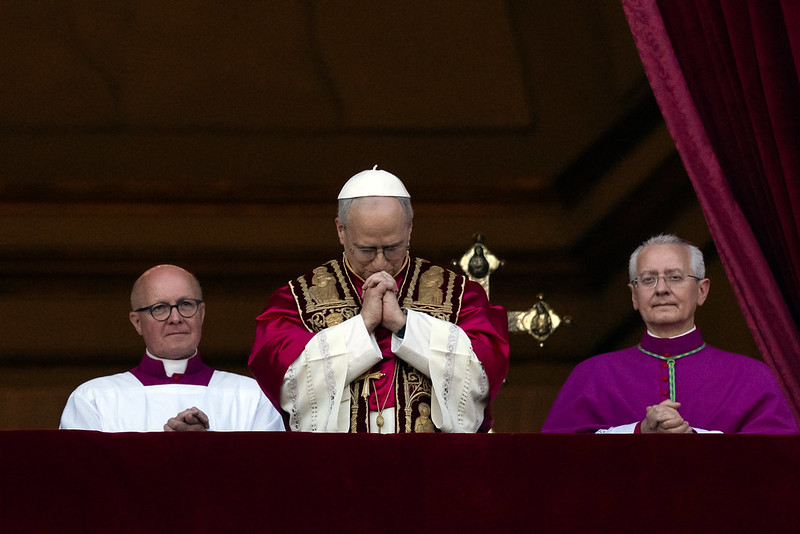

“We walk alongside scientists, leaders and pastors of every nation and creed. We are guardians of creation, not rivals for its spoils. Let us send a clear global signal together: nations standing in unwavering solidarity behind the Paris Agreement and behind climate cooperation,” he emphasised.
UN climate chief Simon Stiell welcomed the message, adding that the Pope’s words “challenge us to keep choosing hope and action, honouring our shared humanity and standing with communities all around the world already crying out in floods, droughts, storms and relentless heat”.
War’s carbon footprint grows but stays off the books
During the Leaders’ Summit that happened just before COP, Brazilian President Luiz Inácio Lula da Silva referred to ongoing conflicts around the world, saying that “spending twice as much on weapons as we do on climate action is paving the way for climate apocalypse”. “There will be no energy security in a world at war,” he added.
But COP30’s schedule doesn’t appear to reflect his concerns, as there’s no mention of any peace initiative on the official schedule and no thematic day for peace, a marked difference from COP28 and COP29, when Baku called for a global truce for the summit’s duration. It didn’t produce the desired result.
And yet discussions about militarism and what it is costing the planet have not been absent from the COP30 halls. The first week saw the publication of ‘Accounting for the uncounted: The global climate impact of military activities’, an analysis by a group of civil society organisations and the University of Warwick that showed how global armed forces produce 5.5% of all greenhouse gas emissions.
If counted as a country, they would be the fourth-biggest emitter, topped only by the US, China and India – and producing more emissions than the continent of Africa.
Ellie Kinney, senior climate advocacy officer with the Conflict and Environment Observatory (CEOBS), one of the organisations behind the report, explained that, while the Paris Agreement made military emissions reporting voluntary, few countries fully comply.
China and the US, the world’s two biggest military spenders, have ceased their partial reporting on them altogether: the US has not sent its annual report to UNFCCC this year, and China said its military emissions are “not occurring”.
Yet the research findings are alarming: the Russia-Ukraine conflict has produced 237 million tonnes of CO₂ over three years, while the Gaza conflict has already surpassed the combined annual emissions of Costa Rica and Estonia. The Afghanistan war was responsible for a staggering 400 million tonnes CO₂, and the EU’s rearmament could lock in 200 million tonnes of CO₂ mainly through the production and transportation of weapons, an activity that uses steel and aluminium, which are very carbon-intensive to produce.
Ana Toni, COP30’s CEO, said back in March that countries that increase their military budgets should also increase their climate spending or face more wars in the future. “Wars come and go. Unfortunately, climate change is there for a long time,” she added.
The European Parliament used its annual COP resolution this year to call on the defence sector to help tackle climate change by cutting its emissions intensity and urged EU decision-makers to formulate a proposal to increase the transparency of military emissions accounting to the UNFCCC.
Campaigners want military emissions reporting to be mandatory, especially after 2024 – the first calendar year to surpass the 1.5C temperature goal and, with 56 wars involving 92 nations, the year with the highest number of active conflicts since WWII.
“We can’t have this future where defence comes at the cost of climate action,” Kinney of CEOBS said. “Military security is not the only security – climate action is part of our collective security, too.”

The post COP30 Bulletin Day 8: Draft decision draws battle lines on fossil fuel transition, finance and trade appeared first on Climate Home News.
COP30 Bulletin Day 8: Draft decision draws battle lines on fossil fuel transition, finance and trade
Climate Change
COP Bulletin Day 8: Pope keeps faith in 1.5C
The United Nations may have accepted that overshooting 1.5C of warming – at least temporarily – is inevitable – but God’s representative on Earth didn’t get the memo.
The new pope, Leo XIV, sent a video message to cardinals from the Global South gathered at the Amazonian Museum in Belém last night, saying “there is still time to keep the rise in global temperature below 1.5°C” although, he warned, “the window is closing.”
“As stewards of God’s creation, we are called to act swiftly, with faith and prophecy, to protect the gift he entrusted to us,” he said, reading from a sheet of paper in front of a portrait of the Vatican.
And he defended the 10-year-old Paris Agreement, saying it has ”driven real progress and remains our strongest tool for protecting people and the planet.” “It is not the Agreement that is failing – we are failing in our response,” he said In particular, the American Pope pointed to“the political will of some.”
“We walk alongside scientists, leaders and pastors of every nation and creed. We are guardians of creation, not rivals for its spoils. Let us send a clear global signal together: nations standing in unwavering solidarity behind the Paris Agreement and behind climate cooperation,” he emphasised.
UN climate chief Simon Stiell welcomed the message, adding that the Pope’s words “challenge us to keep choosing hope and action, honouring our shared humanity and standing with communities all around the world already crying out in floods, droughts, storms and relentless heat”.

The post COP Bulletin Day 8: Pope keeps faith in 1.5C appeared first on Climate Home News.
Climate Change
A fast, fair, full, and funded fossil fuel phaseout
I pause to write this letter in the middle of week one of the 30th UNFCCC Conference of the Parties — the big international climate conference, the space for multilateral decision making to save ourselves from ourselves and rein in the climate crisis. Day two photos showed that a torrential downpour left the blue zone entrance flooded. Mother Nature is present and making her anger known.
This morning I also saw the announcement of Time Magazine’s 100 Climate leaders for 2025. At the top of the list I found the Global Head of Climate Advisory for JP Morgan Chase, Sarah Kapnick. I shook my head, thinking perhaps I was still asleep, and refocused. There it was indeed.
JPMorgan Chase is the world’s largest financier of fossil fuels, having provided over $382 billion since the Paris Agreement, with $53.5 billion in 2024 alone. The bank faces criticism from scientists and activists for its continued large-scale investments, particularly in fossil fuel expansion. How does a person who works for such an institution end up being lauded as a hero working to resolve the climate crisis?
Last week the Guardian released a report from Kick Big Polluters Out showing that over the past four years fossil fuel lobbyists have gained access to negotiation spaces at COP. The roughly 5,350 lobbyists mingling with world leaders and climate negotiators in recent years worked for at least 859 fossil fuel organizations including trade groups, foundations and 180 oil, gas and coal companies involved in every part of the supply chain from exploration and production to distribution and equipment. There are more fossil fuel lobbyists and executives in negotiations than delegates representing the most climate vulnerable countries on the planet.
We’ve known since the late 1800s that greenhouse gas emissions warm the planet. In 1902 a Swedish chemist Svante Arrhenius calculated that burning fossil fuels will, over time, lead to a hotter Earth. But the fossil fuel industry followed Big Tobacco’s playbook and despite knowing the truth, waged a multi-decade, multibillion dollar disinformation, propaganda and lobbying campaign to delay climate action by confusing the public and policymakers about the climate crisis and its solutions. See this report from Climate Action Against Disinformation and the Exxon funded think tanks to spread climate change denial in Latin America.
They’ve infiltrated our K-12 classrooms. The Oklahoma Energy Resources Board, a state agency funded by oil and gas producers, has spent upwards of $40m over the past two decades on providing education with a pro-industry bent, including hundreds of pages of curriculums, a speaker series and an after-school program — all at no cost to educators of children from kindergarten to high school. In Ohio students learn about the beauty of fracking. Even Scholastic, a brand trusted by parents and educators, has attached its seal of approval to pro fossil fuel materials. Discovery Education has also embedded pro oil propaganda into its science and stem free resources.
There is no just transition, no possible way to keep our global temperatures to the limit agreed to in Paris ten years ago without a fast and fair phase out of fossil fuels. We know this is possible, during the first half of 2025, renewables generated more electricity than coal. As UN General Secretary António Guterres said in his opening remarks in Belem, “We’ve never been better equipped to fight back… we just lack political courage.”
Next year, I hope that TIME’s Climate 100 is a list of indigenous climate activists from around the world, whose leadership has led us to find the political courage Guterres spoke of, the courage to do the right thing and phase out fossil fuels forever.
Susan Phillips
Executive Director
Photo by Andrea DiCenzo
The post A fast, fair, full, and funded fossil fuel phaseout appeared first on Climate Generation.
-
Climate Change3 months ago
Guest post: Why China is still building new coal – and when it might stop
-
Greenhouse Gases3 months ago
Guest post: Why China is still building new coal – and when it might stop
-
Climate Change2 years ago
Spanish-language misinformation on renewable energy spreads online, report shows
-

 Greenhouse Gases1 year ago
Greenhouse Gases1 year ago嘉宾来稿:满足中国增长的用电需求 光伏加储能“比新建煤电更实惠”
-
Climate Change Videos2 years ago
The toxic gas flares fuelling Nigeria’s climate change – BBC News
-

 Climate Change1 year ago
Climate Change1 year ago嘉宾来稿:满足中国增长的用电需求 光伏加储能“比新建煤电更实惠”
-

 Carbon Footprint2 years ago
Carbon Footprint2 years agoUS SEC’s Climate Disclosure Rules Spur Renewed Interest in Carbon Credits
-
Renewable Energy4 months ago
US Grid Strain, Possible Allete Sale



